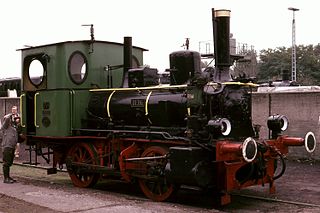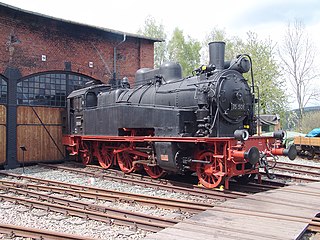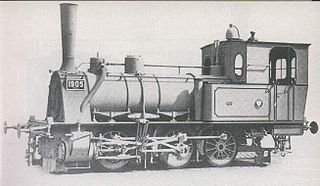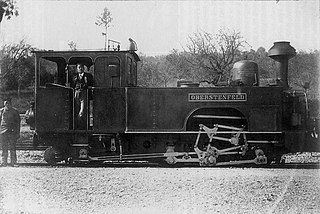
A steam locomotive is a locomotive that provides the force to move itself and other vehicles by means of the expansion of steam. It is fuelled by burning combustible material to heat water in the locomotive's boiler to the point where it becomes gaseous and its volume increases 1,700 times. Functionally, it is a steam engine on wheels.

A Fairlie locomotive is a type of articulated steam locomotive that has the driving wheels on bogies. The locomotive may be double-ended or single ended.

A tank locomotive or tank engine is a steam locomotive which carries its water in one or more on-board water tanks, instead of a more traditional tender. Most tank engines also have bunkers to hold fuel; in a tender-tank locomotive a tender holds some or all of the fuel, and may hold some water also.
Under the Whyte notation for the classification of steam locomotives, 0-8-0 represents the wheel arrangement of no leading wheels, eight powered and coupled driving wheels on four axles and no trailing wheels. Locomotives of this type are also referred to as eight coupled.

Under the Whyte notation for the classification of steam locomotives by wheel arrangement, a 4-6-2+2-6-4 is a Garratt or Union Garratt articulated locomotive using a pair of 4-6-2 engine units back to back, with the boiler and cab suspended between them. The 4-6-2 wheel arrangement of each engine unit has four leading wheels on two axles, usually in a leading bogie, six powered and coupled driving wheels on three axles, and two trailing wheels on one axle, usually in a trailing truck.

The Class PtL 2/2 locomotives of the Royal Bavarian State Railways were light and very compact superheated steam locomotives for operation on Bavarian branch lines. There were three types in total, of which two were transferred to the Deutsche Reichsbahn-Gesellschaft as Class 98.3 tank locomotives and even survived to join the Deutsche Bundesbahn fleet after the Second World War.

The Bavarian Class D VI were German, 0-4-0, steam locomotives of the Royal Bavarian State Railways. They were light, twin-coupled, saturated steam, tank engines. Maffei supplied the first 30 locomotives from 1880 to 1883, and Krauss delivered a further 23 up to 1894.
The only Bavarian Class Gts 4/4 locomotive in the Royal Bavarian State Railways was built in 1909 for the meter gauge line between Eichstätt and Kinding.
The steam locomotives of Bavarian Class LE were narrow gauge engines with the Royal Bavarian State Railways.

The steam locomotives of DR Class 99.77–79 were ordered by the Deutsche Reichsbahn in East Germany after the Second World War. They were narrow gauge locomotives with a 750 mm rail gauge and were built for the narrow gauge lines in Saxony. The locomotives were largely identical to the DRG Class 99.73–76 standard locomotives (Einheitslokomotiven) built in the 1930s. To differentiate them from their predecessors they were described as Neubaulokomotiven or newly designed engines.

The Saxon Class XIV T locomotives were six-coupled tank engines operated by the Royal Saxon State Railways for mixed duties on main and branch lines. In 1925, the Deutsche Reichsbahn grouped them into their DRG Class 75.5.

The Saxon Class V K were German 0-8-0T narrow gauge steam locomotives operated by the Royal Saxon State Railways which had been primarily intended for the Müglitztalbahn. In 1925 the Deutsche Reichsbahn incorporated arranged these locomotives as DRG Class 99.61.
The steam locomotives of Oldenburg Class B of the Grand Duchy of Oldenburg State Railways were built in the early 1900s for working the metre gauge network on the German island of Wangerooge.

The narrow gauge steam locomotives of Palatine L 1 and Pts 3/3 N of the Palatinate Railway were procured for lines in the area of Ludwigshafen, Neustadt an der Weinstrasse and Speyer. On the formation of the Reichsbahn the engines were given the running numbers 99 081 to 99 093.

The Prussian Class T 3 steam locomotives procured for the Prussian state railways were 0-6-0 tank locomotives. Together with the Prussian T 2 they were the first locomotives that were built to railway norms. The first units were delivered by Henschel in 1882.
The engines of Baden Class I b were very early German steam locomotives built for the Grand Duchy of Baden State Railways.
Córas Iompair Éireann No. CC1, generally known as the Turf Burner, was a prototype 0-6-6-0 articulated steam locomotive designed by Oliver Bulleid to burn turf and built at CIÉ's Inchicore Works in Dublin. CC1 shared some, but not all, of the characteristics of Bulleid's previous attempt to develop a modern steam locomotive, the Leader. Like the one completed Leader, CC1 had a relatively short career and was never used in front-line service. It was the last steam locomotive to be constructed for an Irish railway.

The South African Railways Class S2 0-8-0 of 1952 was a steam locomotive.

Under the Whyte notation for the classification of steam locomotives, 0-6-6 represents the wheel arrangement of no leading wheels, six powered and coupled driving wheels on three axles and six trailing wheels on three axles. All locomotives with this wheel arrangement were tank locomotives; no 0-6-6 tender locomotives were recorded.

The Württemberg Tss 4 was a class of three 750-mm gauge 0-8-0T locomotives of the Royal Württemberg State Railways (Königlich Württembergischen Staats-Eisenbahnen, K.W.St.E.). They were used on the Bottwartalbahn between Heilbronn Süd and Marbach am Neckar. While in service, the locomotives were based at Beilstein. The Tss 4 were the first 750-mm gauge steam locomotives to be equipped with the Klose drive system.















